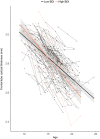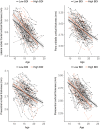Emerging depression in adolescence coincides with accelerated frontal cortical thinning
- PMID: 29577280
- PMCID: PMC6120477
- DOI: 10.1111/jcpp.12895
Emerging depression in adolescence coincides with accelerated frontal cortical thinning
Abstract
Background: Adolescence is a transition period characterized by heightened emotional reactivity, which for some sets the stage for emerging depressive symptoms. Prior studies suggest that adolescent depression is associated with deviant cortical and subcortical brain structure. Longitudinal studies are, however, currently scarce, but critical to detect which adolescents are at risk for developing depressive symptoms.
Methods: In this longitudinal study, a community sample of 205 participants underwent magnetic resonance imaging (MRI) in three biennial waves (522 scans) spanning 5 years across ages 8-25 years. Depressive symptomatology was assessed using self-report at the third time point. Mixed models were used to examine the relations between structural brain development, specifically regional change in cortical thickness, surface area and subcortical volumes (hippocampus and amygdala), and depressive symptoms.
Results: Accelerated frontal lobe cortical thinning was observed in adolescents who developed depressive symptoms at the third time point. This effect remained after controlling for parent-reported affective problems at the first time point. Moreover, the effect was driven by specific lateral orbitofrontal and precentral regions. In addition, differential developmental trajectories of parietal cortical thickness and surface area in several regions were found for participants reporting higher depressive symptomatology, but these results did not survive correction for multiple comparisons. Volumes or developmental volume changes in hippocampus or amygdala were not related to depressive symptoms.
Conclusions: This study showed that emerging depression is associated with cortical thinning in frontal regions within individuals. These findings move beyond detecting cross-sectional correlations and set the stage for early detection, which may inform future intervention.
Keywords: MRI; Adolescence; brain development; cerebral cortex; depression; longitudinal.
© 2018 The Authors. Journal of Child Psychology and Psychiatry published by John Wiley & Sons Ltd on behalf of Association for Child and Adolescent Mental Health.
Figures


Similar articles
-
Brain Structural Signatures of Adolescent Depressive Symptom Trajectories: A Longitudinal Magnetic Resonance Imaging Study.J Am Acad Child Adolesc Psychiatry. 2017 Jul;56(7):593-601.e9. doi: 10.1016/j.jaac.2017.05.008. Epub 2017 May 15. J Am Acad Child Adolesc Psychiatry. 2017. PMID: 28647011
-
Cortico-amygdalar maturational coupling is associated with depressive symptom trajectories during adolescence.Neuroimage. 2017 Aug 1;156:403-411. doi: 10.1016/j.neuroimage.2017.05.051. Epub 2017 May 24. Neuroimage. 2017. PMID: 28549797 Free PMC article.
-
Longitudinal changes in cortical thickness in autism and typical development.Brain. 2014 Jun;137(Pt 6):1799-812. doi: 10.1093/brain/awu083. Epub 2014 Apr 22. Brain. 2014. PMID: 24755274 Free PMC article.
-
The functional neuroanatomy of depression: distinct roles for ventromedial and dorsolateral prefrontal cortex.Behav Brain Res. 2009 Aug 12;201(2):239-43. doi: 10.1016/j.bbr.2009.03.004. Epub 2009 Mar 17. Behav Brain Res. 2009. PMID: 19428640 Free PMC article. Review.
-
Reward Processing in Adolescent Depression Across Neuroimaging Modalities.Z Kinder Jugendpsychiatr Psychother. 2019 Nov;47(6):535-541. doi: 10.1024/1422-4917/a000663. Epub 2019 Apr 8. Z Kinder Jugendpsychiatr Psychother. 2019. PMID: 30957688 Free PMC article. Review.
Cited by
-
Behavioral and Neural Pathways Supporting the Development of Prosocial and Risk-Taking Behavior Across Adolescence.Child Dev. 2020 May;91(3):e665-e681. doi: 10.1111/cdev.13292. Epub 2019 Aug 27. Child Dev. 2020. PMID: 31452199 Free PMC article.
-
Understanding the emergence of suicidal thoughts and behaviors in adolescence from a brain and behavioral developmental perspective.Neuropsychopharmacology. 2025 Jul 25. doi: 10.1038/s41386-025-02168-2. Online ahead of print. Neuropsychopharmacology. 2025. PMID: 40715769 Review.
-
Neural activation and connectivity in offspring of depressed mothers during monetary and social reward tasks.Biol Psychol. 2024 Jan;185:108724. doi: 10.1016/j.biopsycho.2023.108724. Epub 2023 Nov 18. Biol Psychol. 2024. PMID: 37981097 Free PMC article.
-
Causal Analyses of Associations Between Brain Structure and Suicide Attempt in Adulthood and Late Childhood.JAACAP Open. 2025 Mar 21;3(3):455-466. doi: 10.1016/j.jaacop.2025.02.005. eCollection 2025 Sep. JAACAP Open. 2025. PMID: 40922780 Free PMC article.
-
Trajectories of depressive symptoms through adolescence as predictors of cortical thickness in the orbitofrontal cortex: An examination of sex differences.Psychiatry Res Neuroimaging. 2020 Sep 30;303:111132. doi: 10.1016/j.pscychresns.2020.111132. Epub 2020 Jun 20. Psychiatry Res Neuroimaging. 2020. PMID: 32599448 Free PMC article.
References
-
- Achenbach, T.M. , & Rescorla, L.A. (2000). ASEBA preschool forms & profiles. Burlington, VT: University of Vermont, Research Center for Children, Youth and Families.
-
- Beck, A.T. , Steer, R.A. , & Brown, G.K. (1996). Beck depression inventory‐II. San Antonio, 78, 490–498.
-
- Braams, B.R. , & Crone, E.A. (2016). Longitudinal changes in social brain development: Processing outcomes for friend and self. Child Development, 88, 1952–1965. - PubMed
-
- Caetano, S.C. , Fonseca, M. , Hatch, J.P. , Olvera, R.L. , Nicoletti, M. , Hunter, K. , … & Soares, J.C. (2007). Medial temporal lobe abnormalities in pediatric unipolar depression. Neuroscience Letters, 427, 142–147. - PubMed
Publication types
MeSH terms
LinkOut - more resources
Full Text Sources
Other Literature Sources
Medical

